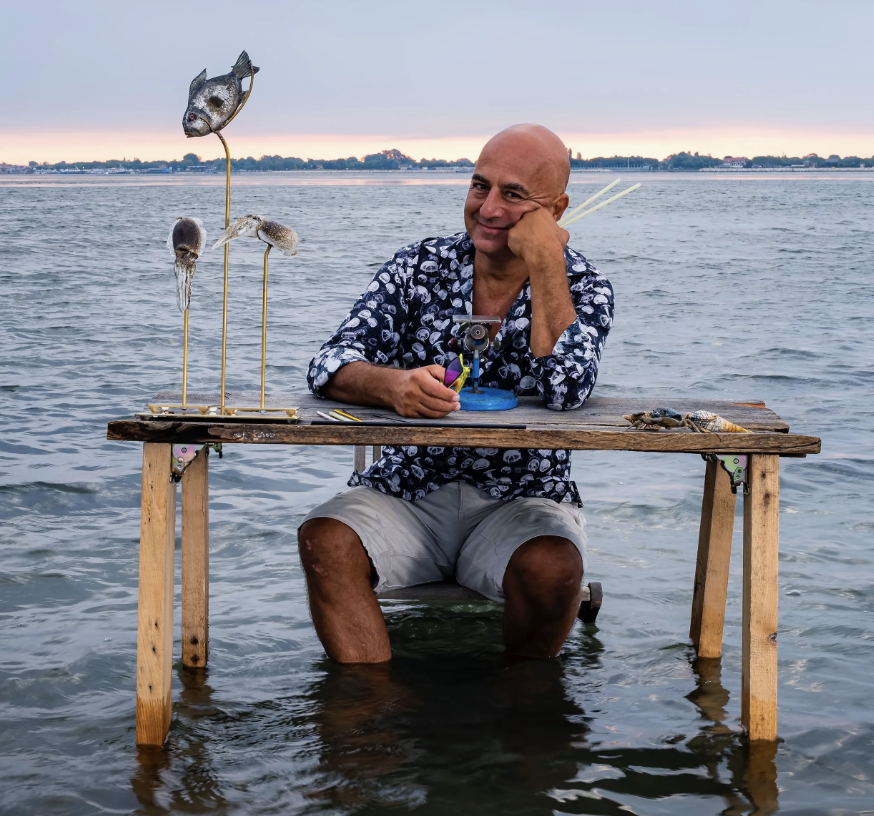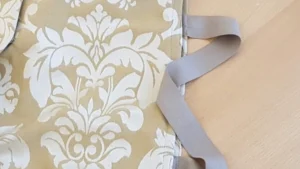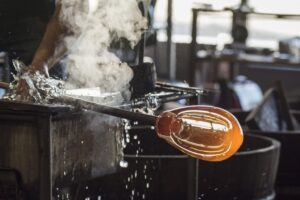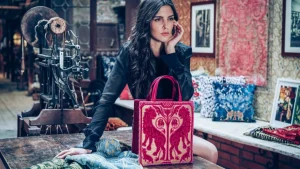In a quiet street near Venice’s Grand Canal, the glow of a small flame illuminates hundreds of translucent sea creatures—fish, coral, octopi, shells, all sculpted from glass so vivid they seem to move. Behind the flame sits Mauro Vianello, one of Venice’s most respected lamp-work artists and a man whose imagination has carried the traditions of Murano glass into the modern world. His art travels across continents, yet every piece begins with a single breath over the torch, in the same city that gave birth to glass itself.
1️⃣ A Venetian Born of Water and Fire
Mauro Vianello was born in Venice, surrounded by light and reflection. The lagoon was his first classroom; the boats, shells, and tides became his earliest inspiration. Growing up in a city that lives between sea and sky, he developed a fascination for the underwater world—the delicate balance of motion and transparency that would one day define his art.
As a young apprentice, he studied the ancient techniques of Murano glass. But rather than repeating the ornamental chandeliers and vases that dominated the island’s furnaces, Mauro turned his gaze elsewhere: to the quiet, mysterious life beneath the waves. He began experimenting with lamp-work—a precise form of glass-sculpting using a small open flame—and discovered that glass could imitate the shimmer of scales, the curve of a fin, even the pulse of a jellyfish. It was the perfect medium for his obsession with the sea.
He often says, “Venice is the only city where the sea is inside your blood.” That philosophy would guide him for decades, pushing him to transform observation into emotion, technique into storytelling.
2️⃣ The Art of Lamp-Work: Breathing Life into Glass
In lamp-working, the artisan uses a torch flame to melt thin rods of glass, then shapes them with steel tweezers, paddles, and gravity. Every motion counts; every pause risks collapse. The glass must stay alive—never too hot, never too cold. It is art performed between seconds.
Mauro Vianello mastered this dance until it became an extension of his hand. His workshop, known as Glass Handmade Venice, feels like an artist’s laboratory: glass rods of every color stacked like organ pipes, sketches of coral and jellyfish pinned to the walls, and sculptures in every stage of transformation. From a single rod of molten glass, he can coax a clownfish with translucent fins or a hermit crab crawling into its shell. Each piece is unique, each a frozen heartbeat of motion.
What sets Mauro apart from other glass artists is his sense of realism. His sea creatures are not stylized—they are biological studies rendered in glass. Visitors often mistake them for specimens preserved in crystal. Yet within that realism is poetry: the shimmer of blue within clear transparency, the soft diffusion of light that mimics seawater, the suggestion of breath inside solid form.
3️⃣ Inspiration from the Depths
Vianello’s fascination with marine life began in childhood, when he would fish with his father in the Venetian lagoon. The lagoon’s fragile ecosystem—its tides, reeds, and quiet shoals—inspired in him both wonder and respect. As he grew older, he studied the scientific illustrations of sea life from 19th-century Venice and admired the glass models of Leopold and Rudolf Blaschka, two Bohemian artisans whose botanical and zoological sculptures for Harvard University became world-famous.
But Mauro wanted to go further. The Blaschkas worked for museums; he wanted to work for the soul. Instead of reproducing scientific specimens, he created dreamlike portraits of underwater life—part reality, part reverie. His seahorses bend into spirals of color; his jellyfish appear mid-movement, their tentacles whispering light. Each sculpture is a meditation on fragility and endurance—qualities Venice itself knows well.
4️⃣ Recognition Beyond the Lagoon
By the early 2000s, Mauro Vianello’s work had begun to attract attention beyond Venice. Collectors and museums recognized that his sculptures were not merely decorative objects but contemporary artworks blending science, tradition, and emotion. Over the next two decades, his pieces traveled around the globe.
- Italy & Europe: His sea-life collection was exhibited in Florence, Rome, Milan, and at the Murano Glass Museum, where critics praised his ability to “capture the soul of movement in stillness.”
- United States: Mauro’s lamp-work demonstrations and masterclasses appeared in galleries and universities from New York to Chicago. His coral installations were featured in several contemporary design shows focusing on sustainability and the marine environment.
- Japan: His work resonated deeply with Japanese collectors, who saw in his precision and restraint a harmony similar to their own crafts. In Tokyo and Osaka, he led workshops on Venetian flame-technique and exhibited at international glass fairs.
- Australia: Mauro participated in “Venice Reimagined,” a traveling exhibition celebrating Venetian artisans, introducing his sea creatures to new audiences fascinated by the parallels between Venetian and Pacific waters.
- Homo Faber Venice: In 2022 and 2023 he was selected as one of the Italian masters featured by the Michelangelo Foundation’s Homo Faber Guide, placing him among Europe’s most important living artisans.
Through these journeys, he became an ambassador of Venice—proving that centuries-old crafts could still innovate, inspire, and move modern audiences.
5️⃣ Collaboration & Creative Dialogues
Mauro’s glass sculptures have entered collaborations with designers, scientists, and even environmental organizations. His coral and jellyfish pieces have been used in ocean-conservation exhibits to draw attention to the fragility of marine ecosystems. Curators have praised how his art transforms ecological awareness into visual poetry—reminding viewers that beauty and preservation are inseparable.
Fashion designers have commissioned his miniature sea creatures for high-end collections; interior decorators have integrated his transparent shells into chandeliers and installations. He has worked with international universities as a guest lecturer, teaching students not only technique but philosophy: “Glass,” he tells them, “is time made visible.”
One of his proudest collaborations involved creating a large coral reef entirely from glass for a museum in northern Italy. Each coral branch required hours of torch-work and precise color blending. The finished installation shimmered under light like a living reef—fragile, luminous, and alive in spirit.
6️⃣ Teaching the Next Generation
In his Venetian studio, Mauro welcomes students from every corner of the world. Some are professional artists seeking to refine their technique; others are travelers simply curious about how glass can move like water. With infinite patience, he demonstrates the delicate balance between heat and gravity, between control and release. He lets each student shape a small piece—often a shell or fish—so they can feel how the material responds.
He insists on silence during the critical moments of shaping. “You must listen to the glass,” he says. “It speaks when it is ready.” That silence becomes part of the art—an echo of Venice’s calm backstreets, where the loudest sound is the splash of an oar or the hiss of a torch.
Through his workshops, Mauro keeps the ancient Venetian tradition alive not by freezing it in time, but by opening it to the future. Every visitor who learns from him becomes part of the lineage of Venetian craftsmanship—one that stretches back more than 700 years.
7️⃣ A Global Language of Light
What makes Mauro Vianello’s art so universally admired is its ability to communicate across cultures without words. A glass seahorse in Venice, a jellyfish in New York, a coral in Kyoto—all speak the same emotional language: wonder. Viewers see fragility yet feel strength; they recognize movement in stillness; they sense water inside flame.
Critics often describe his work as “liquid sculpture.” Collectors value it not only for its craftsmanship but for its symbolism: the eternal connection between humanity and nature, between Venice and the sea. Each sculpture is signed, not with a signature but with a tiny murrina—a colored glass dot sealed into the piece, representing his identity as a Venetian artisan.
8️⃣ Inside the Studio: Where Magic Is Made
Mauro’s studio in the Santa Croce district is both workshop and sanctuary. Visitors step through a modest door into a world of color and reflection. On the shelves rest hundreds of small glass creatures, illuminated by soft lagoon light. Nearby, the torch flickers continuously; the smell of heated metal mingles with faint notes of salt air from the canal.
He begins each day early, sometimes before sunrise, sketching new designs inspired by what he saw on the water the night before. A passing jellyfish, the curl of a wave, even the way light refracted through rain can spark a new piece. Once he ignites the torch, hours disappear. The workshop grows hot; the air vibrates with concentration. By evening, a new creation rests cooling on the bench—a small miracle of patience and precision.
Every visitor who meets him senses the same thing: this is not production; it is devotion. Mauro speaks little while working, but when he looks up from the flame, his smile says everything—pride, humility, and joy that the ancient fire of Venice still burns in his hands.
9️⃣ The Aesthetic of the Sea
For Mauro, the sea is not just inspiration—it is identity. Its rhythm defines his compositions, its translucence defines his palette. He often chooses colors found nowhere else in Murano glassmaking: the pale turquoise of shallow lagoons, the smoky violet of dawn fog, the silver-green shimmer of eelgrass. His palette shifts like tides, sometimes bright and playful, sometimes muted and mysterious.
Each sculpture tells a silent story. A glass crab crawling into a shell becomes a metaphor for home; a jellyfish floating upward becomes hope; a coral reef becomes community. Through these symbols, he captures the spiritual dimension of Venice—the eternal balance between fragility and strength.
🔟 Venice and the World: A Cultural Bridge
Mauro Vianello travels regularly for exhibitions and artist-in-residence programs. From the United States to Japan, France to Australia, his demonstrations have inspired audiences who had never seen Venetian lamp-work in person. In 2015 he was invited to the Venice Biennale Satellite Exhibit for contemporary artisans, where his coral installation “Laguna Viva” attracted international press. Two years later, he participated in Glass in Motion, a European touring exhibition linking Venice, Prague, and Amsterdam.
During residencies in Berlin and Barcelona, he collaborated with contemporary sculptors and digital artists, merging traditional glasswork with new-media projection. One project, titled Breath of Water, combined real glass jellyfish with holographic animation, creating an immersive experience that blurred the line between material and illusion. Critics hailed it as “a new Renaissance for Venetian craftsmanship.”
His works now reside in private collections across Europe, America, and Asia, as well as in museums dedicated to contemporary design. Despite this international acclaim, Mauro always returns home. “Every time I travel,” he says, “I carry Venice with me in the glass—and when I return, I bring the world back to Venice.”
11️⃣ The Balance of Old and New
Perhaps Mauro Vianello’s greatest achievement is his ability to unite centuries-old technique with contemporary sensibility. He honors the precision of Murano masters while infusing it with modern minimalism. Where older glassworks might appear ornate, his are organic and essential. The curves are natural; the compositions feel alive. His pieces belong as easily in a 16th-century palazzo as in a modern art museum.
This duality mirrors Venice itself—a city where history and innovation coexist. Through Mauro’s art, visitors glimpse how tradition can evolve without losing integrity. His sea creatures are at once timeless and modern—reflections of a lagoon that is eternal, yet ever-changing.
12️⃣ The Emotional Core: Why His Work Moves Us
Art critics often analyze technique, color, and composition, but the true power of Mauro Vianello’s glass lies in emotion. People stand before his sculptures and feel something—a quiet sadness, a flash of joy, a memory of the sea. The glass awakens memory because it carries light within it. When illuminated, the creatures seem to breathe. They remind us of nature’s beauty, of our own impermanence, of Venice’s luminous fragility.
In a world dominated by mass production, his work restores the sacred link between hand and heart. Watching him sculpt reminds viewers that art is not only seen—it is felt through heat, rhythm, and time.
13️⃣ Visiting Mauro Vianello in Venice
Travelers who wish to meet Mauro or witness Venetian lamp-work firsthand can do so through curated experiences with Tour Leader Venice. We organize intimate visits to authentic studios like his—far from the crowded tourist demonstrations—and offer exclusive workshops where guests can learn the principles of lamp-work directly from local masters.
During your private tour, you’ll see the delicate transformation from raw glass rods to living sculpture, hear stories of Venetian craftsmanship passed down through generations, and gain a deeper appreciation for how Venice’s artisans keep the city’s soul alive. You may even meet Mauro himself and watch as he creates a sea creature before your eyes—a silent conversation between flame and imagination.
Join Our Murano Glass Workshop Tour
14️⃣ The Broader Legacy: Venice’s Artisans in the Modern World
Mauro Vianello represents more than one man’s success—he embodies the resilience of Venetian craftsmanship. In recent decades, Murano has faced competition from imitations and mass-produced imports. Yet artisans like Mauro remind the world that authenticity still matters. Their work cannot be copied because it contains something machines lack: humanity.
Venice’s future depends on such artisans—those who teach, innovate, and inspire. Through their art, they preserve the city’s intangible heritage and ensure that its creative flame continues to burn. Every visitor who witnesses their process becomes part of that preservation.
At Tour Leader Venice, we are proud to collaborate with these masters and introduce travelers to the real heartbeat of the city. Beyond gondolas and postcards, Venice endures through its makers—the people who still wake before dawn, light the furnace, and shape wonder from fire.
🌍 Final Reflection: The Man Who Shapes the Sea
Mauro Vianello’s art is a bridge between worlds—between Venice and the ocean, tradition and innovation, fragility and strength. In each of his creations glimmers the philosophy that defines true Venetian craftsmanship: beauty born of resilience.
To see his work is to understand Venice differently. It’s to realize that this city’s magic does not come only from its palaces or canals, but from the people who keep its ancient arts alive, one glowing ember at a time.
And perhaps that is Venice’s greatest secret—that beneath the surface, in the flicker of a torch and the hands of a man sculpting the sea, the city still breathes, creating light for the world to see.
Experience Venetian Lamp-Work Yourself
© Tour Leader Venice — Authentic Guided Experiences in Venice






